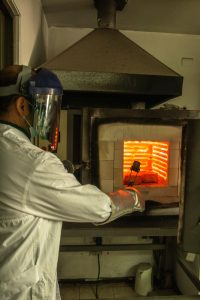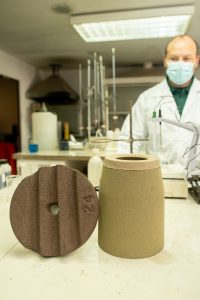Historically, foundries have used a number of materials to cover the uprights and prevent heat loss in the feeders: sands, rice husks, insulating powders and exothermic expansive powders. These, however, are not sufficiently efficient since their dosage depends on the operator and they can produce defects in the feed due to inadequate application.

To solve them and consolidate the feeding system, Quipasur designed and patented a molded tablet whose unique shape and formulation overcome these obstacles and increase system performance.

The existing alternatives on the market, such as exothermic powders, do not always work as they should. One of the most common problems is that the amount added to the upright is insufficient, which causes the solidification of a layer on top of the upright, preventing the action of atmospheric pressure on the liquid metal inside them, reducing their feeding power.
Also, when powder is poured over the top of the metal, it often spills over and does not stay on the top, causing a loss of efficiency of the feeding system, resulting in rejects and loss of parts.

In order to overcome these problems, Quipasur developed its HCP-700 exothermic covering pellet, a cylinder equipped with grooves that ensure heat transfer by radiation to the interior of the pellet, guaranteeing a rapid reaction of the exothermic components when they come into contact with the liquid metal.
The exothermic pellet created and patented by Quipasur can be applied to all types of ferrous alloys and is compatible with exothermic and insulating sleeves. It must be inserted inside the sleeves before casting.
 Marco Salazar, Quipasur's Development Manager, pointed out that "one of the advantages is the operator's safety, since it is not necessary to be close to the fire line when the pieces are melted, as this goes inside the sleeve". He also highlighted "its high efficiency, given that its exclusive formulation allows insulation with a high thickness layer, which minimizes heat loss in the upper part of the uprights, this is achieved because its formula has expandable components. The expansion of an exothermic pellet is of the order of 500 times its original volume, so it completely covers the surface".
Marco Salazar, Quipasur's Development Manager, pointed out that "one of the advantages is the operator's safety, since it is not necessary to be close to the fire line when the pieces are melted, as this goes inside the sleeve". He also highlighted "its high efficiency, given that its exclusive formulation allows insulation with a high thickness layer, which minimizes heat loss in the upper part of the uprights, this is achieved because its formula has expandable components. The expansion of an exothermic pellet is of the order of 500 times its original volume, so it completely covers the surface".
Among other advantages is the use of the correct and adequate amount for each upright size, which minimizes losses due to misuse. With HCP-700 pads, savings of approximately 15% are achieved with respect to other coating materials.
Apart from moving the operator away from the liquid metal pouring area, the use of manpower is reduced by eliminating the weighing operation of exothermic powder in different dosages depending on the diameter of the upright and avoids the operational presence of at least 1 operator in the aggregate at the time of casting, which translates into significant labor savings.
The use of exothermic pellets guarantees the production of a production with lower possibilities of losses due to shrinkage, since the difference in aggregate time is minimized and an even coverage of the upright is ensured.
All of the above translates into a lower cost operation and increased productivity.


